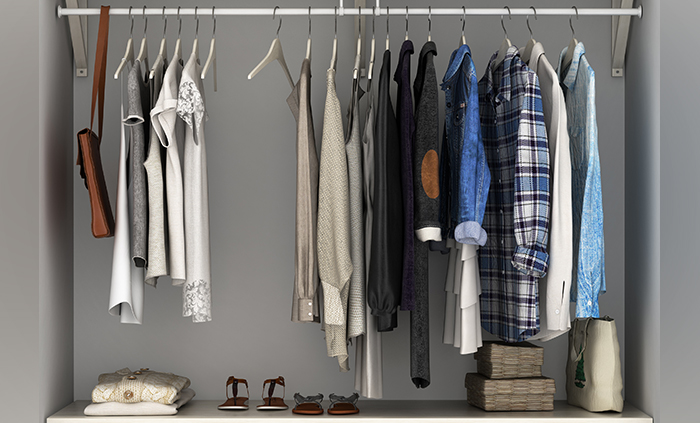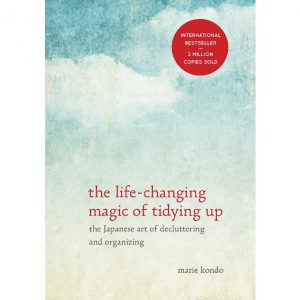Tidying up: Embracing the KonMari Method
Posted on September 28, 2017 at 6:00 am
By Stefani Miller
Three years ago, organizing consultant Mari Kondo released her mega-best seller The Life-Changing Magic of Tidying Up. Many a home and closet were whipped into shape, but no one I knew had taken on Kondo’s challenge. Certainly not me, with my infamous bin full of winter clothes that may or may not still fit.
But this fall a close friend and coworker, Morgan Garratt, checked out Kondo’s audiobook, and it sparked a full-scale exploration and implementation of all that is the KonMari Method.
In simple terms, the KonMari Method means taking something you own, holding it in your hands, and asking yourself if this item brings you joy. If it gives you all the feels, then you keep it. If it doesn’t, you think of a good memory you have with the item, thank it for its service, and move on.
Disclaimer: even though your vacuum cleaner may not bring you joy when you’re gazing at it in the closet, its purpose is practical and the result of using it may bring you joy. Ergo, if it’s practical, it stays.
If this idea seems daunting, Morgan (summarizing Kondo) suggests thinking of it this way: “You’re choosing things to keep. Instead of things to discard.” You’re then left with things you love, instead of just things. Going through this process might also teach you a thing or two about yourself.
“I’ve learned I dislike twist top travel mugs,” says Morgan. “I never use mine, so it had to go. I didn’t have a particularly great memory associated with it, so I thanked it for teaching me that I didn’t like twist tops.”
For more insight into the art of tidying, I sat down with Morgan to ask her some questions about her journey so far and if she’s experienced any life-changing magic.
Stefani Miller: As a self-proclaimed “lover of stuff” what made you choose the KonMari Method in the first place?
Morgan Garratt: In all honestly, I had a meltdown while digging in a pile of clothes on my floor. In that moment, I knew something had to be done.
SM: Why did you start tidying where you did?
MG: Kondo’s theory is that you should start tidying with the things that are closest to you. A great example is your clothes, which are immediately on your body. So I started with my clothes, gathered them from their hiding places, and then began the process of sorting them.
SM: What was the hardest part of this process?
MG: After I finished tidying my first large batch of clothing, I felt amazing. But when I dumped the next pile on my bed, I found myself less than enthused at the prospect of sorting through any more clothes. I had no idea how big my closet was until I got started.
SM: What’s something you had a surprisingly hard time letting go?
MG: My grandmother’s sweater. She was much shorter than I am, and I realized that it just wasn’t going to fit me. It had been in my closet for a decade completely unworn. I didn’t totally let go of it though, currently it’s serving as a pillow case.
SM: What’s something surprising you found in your stuff?
MG: I am addicted to multiples. I had four copies of the novel Dune, I had more lotion than any person has a right to have. I also like to buy the same shirt in multiple colors. Which is fine but only to a point. If I can have only one of something, I have more room for something else.
SM: Do you have regrets once you’ve let something go?
MG: Yes and no. The whole point of saying thank you to the item is letting regret go. I gave away things that reminded me of good times but didn’t necessarily define the experience that I was thinking of in that moment. I had to embrace the idea that others might find joy with them as well.
SM: You said you have been careful about where you let things go? What do you mean?
MG: I had a lot of professional wear that I was prepared to let go, and I found unexpected happiness in donating them to Dress for Success, who provide female job seekers with an empowering outfit for interviews and first days on the job. I donated the rest to ARC of Spokane, another cause I was happy to contribute to.
Basically I was choosy about where, who, and what cause my things were going to go to. This helped me to feel like I was doing some extra good in my community.
SM: Do you have advice for someone who gets “stuck” during tidying up?
MG: Choose the one thing in the pile that makes you the happiest. After the first one, it gets easier. Don’t be afraid to grab a friend who will give you a little tough love if you need it.
SM: Where has the KonMari Method made the biggest difference in your life so far?
MG: I have started thinking a lot more about the things I buy before I buy them. I ask myself these questions: Do I have something similar already? Which one is better? Will this replace something else I already have? And, would I buy this next week or is it simply an impulse buy today?
SM: You talked about this experience making you more mindful of the things that surround you. How so?
MG: I think we let a lot of things stand in our way both mentally and physically. I can’t do something because “blank” is standing in my way. Sometimes our stuff can be a physical manifestation of what’s holding us back in our mind or hearts.
It also reminded me that my stuff affects other people, not just at my home but also at work or in relationships. We gather a lot of physical reminders of friendships, romantic relationships, and family life that can pile up putting pressure on both us and those we love.
SM: This whole thing sounds stressful! Have you found yourself often feeling stressed during the process?
MG: Not really during the process, but I did feel anxiety before starting. I was afraid I would start and then be unable to finish. Once I got started though I just felt lighter, like there was more space in my life and my brain.
SM: How do you feel now that you’re midway through your tidying?
MG: I honestly can’t wait to keep going. The KonMari Method has brought me a sense of peace of mind. I no longer have to dig through my closet for a shirt or pants. They are simply there and ready for me to use.
Talking with Morgan really gave me a lot to think about, and I hope it will do the same for you. Even if the idea of parting with your stuff is a little scary, it seems the end result can actually be therapeutic.
If you’re interested in learning more about the KonMari Method the library has all of Marie Kondo’s books as well as other guides to help with organization.
Good luck and happy tidying!
Helpful tips for tidying
- Don’t involve family if you feel that their judgment might affect you letting go of certain items or heirlooms. Make this mostly about you and how you feel about your stuff.
- Are you clean at home but cluttered at work? KonMari your office space. Getting rid of old papers, outdated emails, and books or manuals you don’t use anymore can really free you up. Plus, your desk drawers will thank you.
- Do you store vertically? The bottom of the pile tends to get lost in oblivion, which won’t happen if there’s no pile to speak of.
- If you’re really struggling to part with something, ask yourself if you can reuse it in some way. If you’re in love with your favorite marathon T-shirt, but it’s falling apart, consider framing it or crafting it onto a canvas bag.
Tags: ARC of Spokane, authors, books, clutter, declutter, DIY, donating, downsize, downsizing, Dress for Success, KonMari Method, Mari Kondo, q&a, reading, The Life-Changing Magic of Tidying Up, tidy



